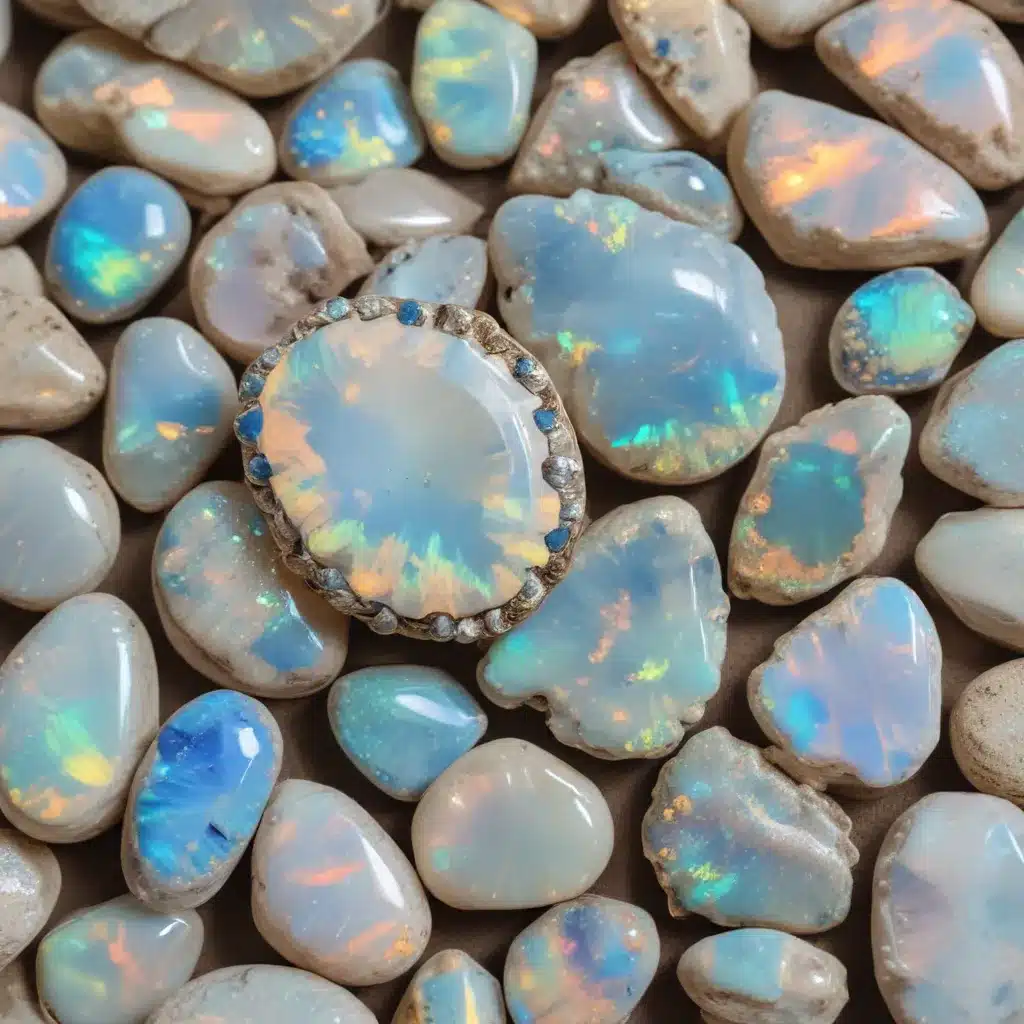
The opal is a captivating gemstone that has beguiled human civilization for millennia. With its mesmerizing play-of-color and prismatic display, the opal has rightfully earned the moniker “queen of gems.” From the fiery hues of Mexican fire opals to the serene blue-green tones of Peruvian varieties, these gemstones offer a truly unique and enigmatic beauty that sets them apart from their crystalline counterparts.
Opal Formation and Structure
Opals are primarily formed in sedimentary rock environments, unlike many other gemstones that crystallize under intense pressure and heat. The unique formation process of opals is what gives rise to their exceptional optical properties. As silica-rich water percolates through rock crevices and cavities, the evaporation of this water leaves behind solid deposits of silica, which eventually harden into amorphous or non-crystalline opals.
The play-of-color in opals is a result of the arrangement of these silica spheres within the gemstone. When light enters the opal, it refracts and diffracts off the tightly packed silica spheres, producing the captivating spectral colors that we associate with these gems. The size, shape, and ordering of the silica spheres determine the specific pattern and range of colors displayed by each opal.
Varieties of Opal
Opals come in a wide array of varieties, each with its own unique charm and allure. Some of the most notable types include:
Australian Opals
Australia is the world’s primary source of opals, accounting for around 95% of global opal production. The country is renowned for its diverse opal varieties, including the classic white opal, black opal, boulder opal, and crystal opal.
Ethiopian/Welo Opals
In recent years, Ethiopian or Welo opals have gained significant attention for their captivating play-of-color and internal “fire” that seems to emanate from within the gemstone.
Mexican Fire Opals
As the name suggests, Mexican fire opals are characterized by their fiery orange and red hues, which are intensified by the gemstone’s typically transparent or translucent nature.
Peruvian Opals
Peruvian opals come in both pink and blue varieties, each with their own soothing and serene qualities. The Peruvian pink opal is renowned for its delicate, blush-pink tones, while the Peruvian blue opal is prized for its calming, ocean-like shades.
The Allure of Opal Jewelry
The opal’s unique and mesmerizing optical properties have made it a highly sought-after gemstone for jewelry design. From elegant opal engagement rings to captivating pendants and earrings, these gems offer endless possibilities for creating truly stunning and one-of-a-kind pieces.
Opal Engagement Rings
While diamonds may be the traditional choice for engagement rings, opals have been gaining popularity as a distinctive and unconventional alternative. The opal’s vivid, ever-changing play-of-color makes it a perfect symbol for the evolving and multifaceted nature of love.
Opal Pendants and Earrings
Opals also lend themselves beautifully to the design of pendants and earrings. Whether set in a delicate prong setting or showcased in a cabochon cut, these gems can elevate any jewelry piece with their enchanting and captivating presence.
Opal in Ancient and Modern Cultures
Opals have a rich and storied history, captivating the imagination of civilizations throughout the ages. From ancient Greece and Rome to the Aboriginal cultures of Australia, these gemstones have been revered for their unique beauty and associated with a wide range of beliefs and symbolism.
Opal in Ancient Civilizations
In ancient Roman times, opals were referred to as the “Cupid stone” and were believed to be the most powerful of all gemstones, symbolizing hope and purity. During the Middle Ages, opals were sometimes associated with bad luck and superstition, due to their shifting colors being linked to witchcraft.
Opal Symbolism and Mythology
In Aboriginal Australian folklore, opals were thought to have been created when a rainbow touched the earth, trapping the colors within the stone. Opals were considered sacred and were believed to have deep spiritual connections to the ancestors.
Opal’s Popularity Today
Today, opals remain a beloved and popular gemstone, particularly as the birthstone for the month of October. Their association with creativity, inspiration, and emotional stability continues to captivate both gem enthusiasts and the general public alike.
Caring for Opal Gemstones
Despite their mesmerizing beauty, opals require gentle care and attention to maintain their integrity and ensure their longevity. As relatively soft gemstones, opals are susceptible to scratches, cracks, and damage, especially if they are exposed to rapid changes in temperature or humidity.
Opal Cleaning and Maintenance
It is crucial to clean opal jewelry gently, using a soft, damp cloth. Avoid exposing opals to harsh chemicals, ultrasonic cleaners, or high-pressure water, as these can compromise the delicate structure of the gem.
Opal Storage and Display
When not in use, opals should be stored in a cool, dry place, away from direct sunlight. Storing opals in a fabric-lined jewelry box or pouch can help protect them from scratches and other physical damage.
Opal’s Vulnerability
The porous nature of opals means that they are also susceptible to absorbing substances they come into contact with, such as perfumes, lotions, and even the natural oils from our skin. To ensure the longevity of your opal jewelry, it is best to put it on after applying any cosmetics or fragrances.
In conclusion, the opal is a truly enigmatic and captivating gemstone that has captivated human civilization for millennia. From its unique formation process to its mesmerizing play-of-color, the opal offers a truly distinctive and enchanting beauty that sets it apart from other gemstones. Whether adorning a stunning engagement ring or accentuating a timeless pendant, the opal continues to captivate and inspire those who are drawn to its enigmatic allure.

